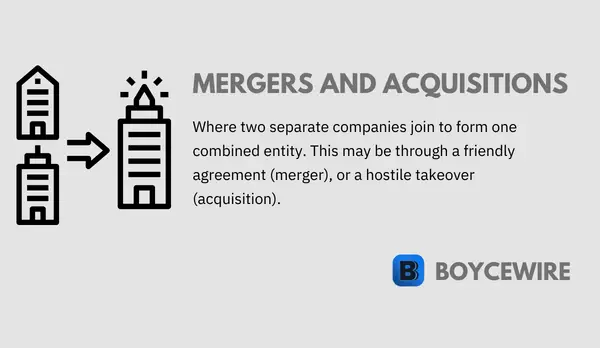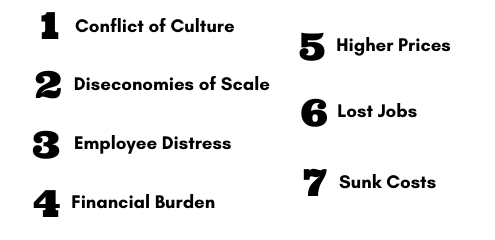Mergers and Acquisitions: Definition, Pros, Cons & Examples

What is a Merger and Acquisition
Mergers and acquisitions refer to the joining of two companies to form one entity. This means everything from its assets, liabilities, and brand image, all become one entity. As a result, it is often seen to produce financial benefits as the combined company becomes more efficient.
Mergers and acquisitions are commonly referred to in the same way. They both reflect the combination of two companies. However, they are slightly different. Mergers reflect the joining of two companies by mutual consent. This usually involves some form of share allocation whereby the instigating firm offers shares in exchange for the merging firm’s shares – thereby creating a single entity. By contrast, an acquisition is more aggressive, whereby the whole ownership is completely transfered. Shareholders are ‘bought out’ and will no longer have a stake in the company.
Key Points
- A merger is when two companies combine to form one entity, without any money being exchanged.
- An acquisition is where one company takes control of another, usually with money being exchanged.
- Mergers are generally friendly agreements between two firms to join and benefit from economies of scale, whilst acquisitions tend to be more hostile.
There are other ways by which a merger may occur, but will result in mutual ownership of the company – with both companies taking an equal share on the board of directors.
An acquisition differs from a merger in the fact that money is exchanged in return for a controlling stake in the company. This might be through purchasing 50 percent of the company’s shares, to give it control over its decisions. Or, it may purchase the whole company upfront. These can be hostile whereby the acquired firm does not approve, or, it can be friendly whereby both are happy with the takeover.
The combined entity may choose to cut jobs and reduce the number of its physical locations – thereby benefiting from economies of scale. In turn, it may see higher profit margins, however, these do not always pan out and can actually have the opposite effect – diseconomies of scale.
Types of Mergers and Acquisitions
There are four main types of mergers and acquisitions – they are: horizontal, vertical, conglomerate, and concentric.

Horizontal
A horizontal merger or acquisition is where the two joining companies operate in the same market, selling similar products. For example, if KFC and McDonalds were subject to a merger or acquisition, it would be known as horizontal. Both firms operate in the fast-food market, selling similar goods.
Through this form of integration, it is likely to result in synergies. As the two firms are in the same industry, they are likely to have areas of the business that overlap. They are then able to condense those operations. For example, the integrated firm may not need two HR or finance departments. It may also benefit from a more integrated distribution network, as well as better negotiating power over suppliers.
Vertical
A vertical merger or acquisition is where the two companies operate at different stages of the supply chain. So this might involve one company purchasing its supplier, or the supplying company purchasing the firm it sells to.
When two firms vertically integrate, they may not benefit from the same synergies as horizontal integration, but there are other advantages. For instance, it has more control over the timings and supply chain – thereby eliminating late and inefficient deliveries. At the same time, it is also able to capture the profitability of the firm along the supply chain, helping to reduce prices to the consumer and compete more fiercely.
Conglomerate
A conglomerate merger or acquisition is where two companies from completely different industries join together. The Amazon acquisition of Whole Foods in 2017 for $13.4 billion is one such example. Whilst Amazon is known for its e-commerce presence, Whole Foods is an American food retailer.
These types of mergers and acquisitions were relatively common in the 1960s, but have since been in decline. This is largely due to the fact that conglomerates are very complex and difficult to combine. There are two different companies with different skillsets and experiences, which mean the potential synergies are limited.
Concentric
A concentric merger or acquisition is where two companies operate in the same industry and have the same customer, but offer different products. These are generally complementary goods. For example, a concentric merger or acquisition would be if PlayStation purchased a game developer such as Activision. Both operate in the gaming market, but PlayStation makes hardware, whilst Activision produces complementary games.
This differs from a conglomerate in the fact that the other company operates in the same industry. It also differs from vertical integration in the fact that the two firms are not buyers or suppliers of each other.
Advantages of Mergers and Acquisitions

1. Access to Talent
In industries such as engineering, construction, software engineering, and programming, there is a shortage of workers. As such, it is difficult for firms to find new, trained, and talented employees to fill vacant positions. This provides a huge benefit to a merger and acquisition because it provides the firm with new talent which they might otherwise be unable to access.
For example, let us look at the Disney acquisition of Pixar in 2006. One of the main reasons for the purchase was to acquire Pixar’s top-class animation studio. This was not only the firm’s psychical assets but also the staff and brains behind the operation. Pixar itself was a huge asset, but much of its value was obtained by
2. Cost Benefits
For companies looking to expand their operations, it is often easier and cheaper to integrate with an existing firm. Instead of having to look for suitable store locations, negotiate on a rent agreement, and find new staff – it can save both time and effort by integrating with an existing firm which has all this arranged.
For example, let us look at Amazon’s acquisition of Whole Foods in 2017. If it wanted to enter the supermarket retail sector, it would have to purchase land, build stores, hire new workers, and do everything else required. Obviously starting a new supermarket business is no easy task. So instead, by purchasing Whole Foods, it is able to set up a presence immediately, with a firm that is established and is viable.
3. Economies of Scale
When two firms join together, they are able to benefit from economies of scale. This could come in the form of lower unit costs driven by lower fixed costs. For example, the business may not need so many stores open – especially if they are in close proximity to one another. It may also benefit from efficiencies that it can achieve. For example, two combining manufacturers may see demand increase, so they can run the factory throughout the day – thereby making more efficient use of both the machinery and the factory space.
Mergers and acquisitions are often associated with synergies. This means that each company has employees doing the same job. However, when they combine, only one of those jobs is necessary, thereby saving the company on labour costs.
4. Financial Power
Mergers and acquisitions can create financial power in a number of ways. First of all, if the integrated company can leverage synergies, it is able to benefit from high-profit margins. Second of all, the combined firm will have higher revenue and a higher value of assets. This can allow it to leverage more debt from financial markets to use for investments. At the same time, it will be able to secure lower rates of interest as the larger business poses less of a risk to investors.
We also have the fact that the integrated firm reduces competition. This gives the firm greater financial power in the market place, allowing it to potentially charge high prices and have greater influence over the consumer. At the same time, it will also be able to negotiate lower prices with suppliers.
5. Reduce Competition
From the customer’s perspective, mergers and acquisitions can reduce competition – which is negative effect for them. However, from the businesses’ perspective, the reduction in competition can be a great advantage. Lower levels of competition put less pressure on it to reduce prices and compete. This means that it is able to charge higher prices and benefit from higher profit margins.
For example, Facebook’s acquisition of Instagram in 2012 was a masterstroke as it took out the competition before it had a chance to fully grow. It has taken over a competitor that has a slightly different offering, but once which was taking consumers away. The acquisition led to not only reduced competition but has also improved its product diversity.
6. Reduce Risk
Mergers and acquisitions allow the firm to diversify. This might be to a completely different market in a foreign country, or, it might be in a slightly different market. By doing so, it allows the combined firm to spread the risk. For instance, Unilever has brands ranging from laundry detergents, to ice creams, to shower gels. So if one of its markets is suffering, it can subsidize it from a more successful part of its business.
If we are looking at international mergers and acquisitions, it also allows diversifying away from domestic risk. For instance, the US economy may not be doing so well, which may in turn impact on profits. However, because the company also operates in China, it is seeing increasing profits from that part of the business. Therefore, any losses in one part of the business may offset losses in another.
7. Tax Advantages
There are a number of tax advantages from a merger and acquisition. First of all, firms with cash on hand may look to integrate instead of issuing dividends. Dividends are taxable, whilst increasing shareholder value is not. Even if the shareholders sell shares at a higher price, they would have to pay capital gains, which is generally a lower tax rate than income tax.
There are also accounting techniques that firms can use. For instance, it can use the integrated firms’ previous years losses to offset its profits and therefore exclude it from taxation. In addition, the assets held by the integrating firm may be undervalued. It can in turn write-up the value of that asset and write off a higher amount under depreciation.
Disadvantages of Mergers and Acquisitions

1. Conflict of Culture
When two firms join in a merger and acquisition, the cultures of them join too. For example, one firm may be very strict and regimented, requiring workers to work overtime hours. However, the other firm may be quite flexible and allow employees to work the hours they choose. Furthermore, there may also be a number of employee benefits which differ between firms.
When the firm tries to standardize these benefits and working conditions, it is likely to de-motivate workers. For example, taking away workers benefits may save the firm money, but alienate half its workforce. However, the alternative would be to introduce such benefits to the other half of the workforce, thereby contributing further to costs.
2. Diseconomies of Scale
The main aim of a merger is to benefit from synergies and economies of scale. However, this does not always pan out in the real world. Firms can actually become too large and cumbersome, where they actually start to become less efficient. For instance, the merger of K-Mart and Sears in the USA was valued at $11 billion in 2005. However, Sears made losses of over $7 billion since the merger and eventually went into bankruptcy in 2018. The synergies of combining a supply chain, administrative costs, and product line, never materialized.
3. Employee Distress
Mergers and acquisitions are tough on the employees. This is because they tend to lead to a large number of redundancies as the new firm seeks to benefit from synergies. This can cause employee distress as they fear that their job may be on the line. At the same time, there are a lot of unknowns which can cause stress. For example, will their generous benefits remain in place, or will they still maintain a flexible working environment. In some cases, employees may be asked to move location. All of this uncertainty only creates further stress for employees.
4. Financial Burden
One of the major disadvantages of a merger and acquisition is that it often results in huge debt. This is because the acquiring firm usually has to borrow huge sums for the investment. Alternatively, the firm it is acquiring or merging with may have a high level of debt. In turn, the integrated firm may have a high level of debt as a result of the transaction.
For example, Vodafone purchased Mannesmann, a predominantly telecoms-based firm, for a record $183 billion in 1999. In the height of the tech boom, it is still the record today. Yet it came at a huge price – one which Vodafone write off over £23 billion in losses in 2013.
5. Higher Prices
If the integrating firm obtains a significant market share, it may have a monopoly type of power in the market. This can allow it to set prices in the knowledge that consumers have nowhere else to go. At the same time, the cost to acquire or merge with another company may force the firm to charge higher prices in order to recoup its investment.
For the firm itself, the lack of competition is a benefit. However, from the consumers perspective, mergers and acquisitions that drastically reduce competition are a huge disadvantage. The higher prices that result can have a huge impact if they fall within necessity goods such as food and energy.
6. Lost Jobs
When two firms integrate, one of the biggest drivers is economies of scale. It can achieve such by combining departments that overlap and cutting jobs. For instance, the firm may only need one HR and Finance department that can handle the combined company. In turn, this will require fewer employees and therefore fewer jobs.
7. Sunk Costs
Mergers and acquisitions involve a significant amount of legal and accounting work that can cost firms millions. If the merger or acquisition doesn’t go through – it can mean significant losses. At the same time, even if it does go through, it is a huge additional cost to the actual price.
Mergers and Acquisitions Examples
Facebook and Instagram
In 2012, Facebook acquired Instagram and its 13 employees in a deal worth $1 billion. Facebook was struggling to target mobile users and was well aware of the competitive environment it was in. The firm didn’t want to become the next MySpace, so decided to diversify and capture Instagram. It has since captured millions of users across the world, which has not only expanded its offerings but also help improve the core Facebook service.
The number of mobile users has increased year on year since 2012 and the capture on Instagram has allowed it to ride this shift away from the desktop. Instagram is more mobile-friendly and allows users to digest information in a more user-friendly photographic format. The acquisition was one of the best investments of the last decade, with Instagram now valued at over $100 billion.
Amazon and Whole Foods
In 2017, Amazon acquired Whole Foods in a deal worth $13.4 billion. It gave Amazon the physical presence across America that it wanted in order to expand in the grocery market. It now allows customers to order online and come and collect from the comfort of their car. This presents significant competition to Walmart who has responded with its $3.3 billion acquisition of Jet.com – with the aim of expanding its online presence to fight Amazon.
Dow and DuPont
In 2017, Dow and DuPont announced a merger in a deal worth $130 billion – forming DowDuPont. Both companies were among the biggest players in the production of polymers, chemicals, and agricultural products. So the merger produced many production benefits with DuPont cutting 10 percent of its staff following the merger. This came as part of a $3 billion cost-cutting initiative that followed the merger with job cuts and store closures.
Heinz and Kraft
In 2015, Heinz and Kraft merged in a deal worth $80 billion. It combined Heinz, a food processor which is famous for its sauces, and Kraft, which is also a food processor, with products in chocolate, biscuits, cheeses, and more. The resulting company, Kraft Heinz, is now the fifth-biggest food and beverage producer in the world, with revenues in excess of $25 billion.
Related Topics
FAQs on Mergers and Acquisitions
A merger is where two firms voluntarily arrange to join together – usually as part of a part exchange of shares. The new company shares the board between the two firms. By contrast, an acquisition can be relatively hostile with the company being taken over resisting the sale. The combined company generally loses most of its board members to the acquiring firm which takes full ownership.
Mergers and acquisitions are important as they allow firms to grow rapidly and benefit from economies of scale.
In the US, mergers and acquisitions are regulated by the Antitrust Division of the Department of Justice (DoJ) alongside the Federal Trade Commission (FTC). In Europe, they are regulated by the European Competition Commission.
About Paul
Paul Boyce is an economics editor with over 10 years experience in the industry. Currently working as a consultant within the financial services sector, Paul is the CEO and chief editor of BoyceWire. He has written publications for FEE, the Mises Institute, and many others.

Further Reading
 Bull Market - A bull market is a financial market where prices of securities are generally rising, indicating positive investor sentiment and a…
Bull Market - A bull market is a financial market where prices of securities are generally rising, indicating positive investor sentiment and a…  Contribution Margin - The contribution margin is a financial metric that represents the amount of revenue available to cover fixed costs and contribute…
Contribution Margin - The contribution margin is a financial metric that represents the amount of revenue available to cover fixed costs and contribute…  Budget Surplus: Definition, Pros, Cons & Effects - A budget surplus is where government brings in more money than it spends.
Budget Surplus: Definition, Pros, Cons & Effects - A budget surplus is where government brings in more money than it spends. 
